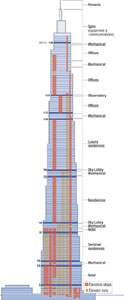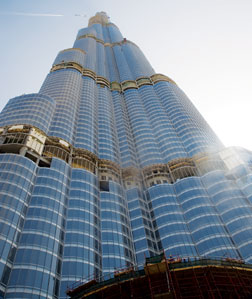... triangles that rotate and decrease in size with the progression in height, ultimately culminating in the pinnacle. The geometry was the result of a rigorous exercise to ensure all spire work points were symmetrically aligned within the building envelope, says the engineer.
| |||||
|
| ||||
There are three primary pinnacle support columns and three secondary pinnacle columns, says SOM. Their work lines form two equilateral triangles, with the pinnacle located in the center of each. As such, the primary pinnacle columns are located to the side of the pinnacle and directly support the pinnacle. The secondary pinnacle support columns are offset farther away from the pinnacle itself and support the primary pinnacle support columns.
Early in its erection, the frame drifted 150 mm from the geometric center. “It became very difficult to bring the steel structure back,” says Abdelrazaq.
But the cagelike spire did not have to align with the tower’s geometric center because it has its own, short-run maintenance elevator. Instead of recentering, crews are erecting the steel straight up after initially centering it to level 156. The straight-up approach represents a change in methodology, says Samsung.
| + click to enlarge |
 F E C
|
The pinnacle will be jacked into place, up through the spire, off the 156th floor. In preparation, workers are installing a support beam at level 156. This will be followed by the lifting block and assemblies. Next, crews will install lifting equipment and assemblies. Crews will jack the pinnacle in a three-step process, says Samsung. After each lift, cladding is installed. Connections are also completed. After the lifting is done, workers will fill holes left in the center of the spire’s floors. Completion is expected in August.
The burj is designed to meet the local energy code. One of the novel MEP systems that crews from the local ETA-Voltas-Hitachi Plant joint venture are installing will reduce the tower’s use of desalinated city water. The system captures condensate off the cooling coils, created from taking in humid fresh air, and recycles it as gray water. “Most buildings in the U.S. and the world dump that water into drainage systems,” says SOM’s Frechette.
The system of holding tanks, pumps and pipes will capture 946,000 liters of water daily, or 60 days of water use annually. “This could fill 20 Olympic-size swimming pools,” says Frechette.
 Michael Goodman / ENR 140,000-sq-m curtain wall will take three to four months to clean.
|
Building water cannot be pumped in a straight shot because of static pressure on pipes and fittings. Instead, it is pumped to tanks and heat exchangers on mechanical floors. The devices separate the pumping circuits and “break” the pressure, allowing water to be pumped to the next-higher mechanical level. To minimize the number of breaks, SOM specified above-standard, high-pressure pipe fittings. Standard fittings would have required another mechanical floor, says Frechette.
Height has also had an impact on power. There would be too great a voltage drop if low-voltage power were vertically distributed, as was the code during design. Instead, allaying official concerns about safety and security, the design team convinced the power authority to allow medium-voltage power up the building to transformers in mechanical levels. There, it is turned into low-voltage power for distribution.
The structure is complete at the tower’s base. Cladding is at level 141. Workers will begin using tower building elevators this month. The multifaceted fit-up remains. “The toughest part is coming,” says George J. Efstathiou, SOM’s managing partner for the project. “There are so many contractors involved, and not all are the best quality,” he says.




Post a comment to this article
Report Abusive Comment